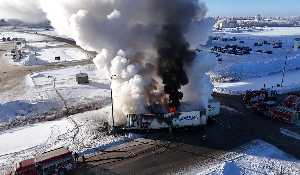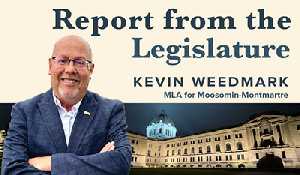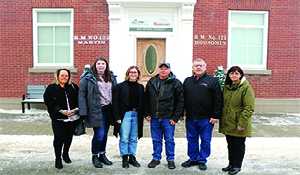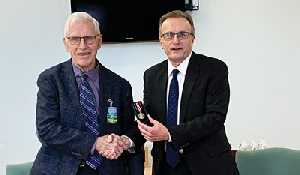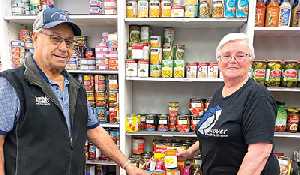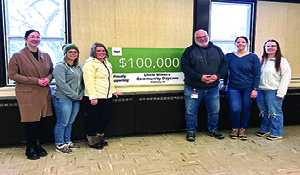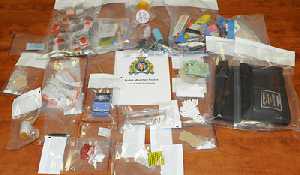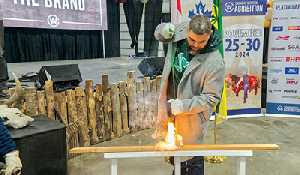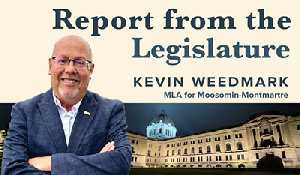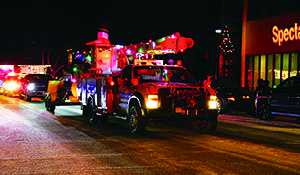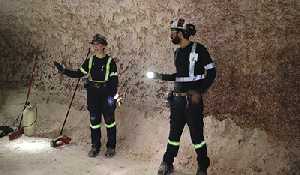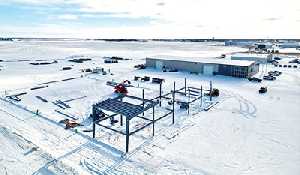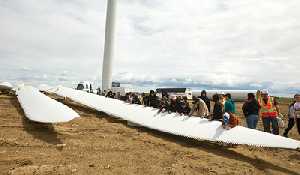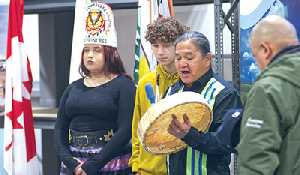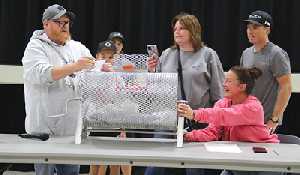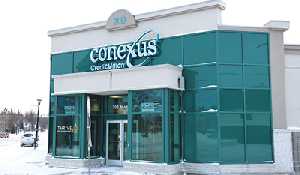Cockrill sees Moosomin as an example of co-operation
June 3, 2024, 11:04 am
Ashley Bochek


Saskatchewan’s Minister of Education Jeremy Cockrill visited Moosomin this past Tuesday.
Cockrill spoke at the Chamber meeting and was interviewed by The World-Spectator after the meeting.
The interview follows:
Tell us why you came to Moosomin today and what were you hoping to get across.
Being Minister of Education, the opportunity that I’ve had the last couple of months to go around all over the province and visit the 27 school divisions and visit several schools, really is the best part of my job—going out and visiting with communities. Certainly, with Moosomin in particular, it is a community that’s growing and we’re seeing investments happening in childcare here with 90 new spots. We just approved those 90 new spots in the fall. I know that there has been some really good collaboration with the childcare centre and the school by making the land available. That’s really exciting.
How unusual is that? To see the school division offer their land like that?
Well I wouldn’t say that it’s completely unusual around the province. Childcare, especially in growing communities that are attracting younger families, is in high demand. It is in the best interest of everybody in the community to get these childcare centres built. There’s probably teachers at the school that are going to have kids at the childcare facility as well. Not every school division has land available like that so it depends on the individual school and how high enrolment is or what the growth looks like, but I’ve got to say, a real shout out to Southeast Cornerstone School Division for seeing an opportunity to provide some free land to make childcare available for the whole community of Moosomin. It really helps the whole general area of Moosomin. There may be people who live out of town but work in Moosomin or work at the school who can use that as childcare. It’s not completely unusual but it’s really nice to see the collaboration.
With the Saskatchewan Teacher’s Federation dispute almost in the rearview mirror, what did you learn from the process?
Bargaining is a challenging process. I think back to the last time I was in Moosomin and we were talking about different community groups working together to do something, and I guess that’s kind of my default setting, which is, ‘Let’s find a way to work together and figure it out,’ but I think when you’re in a bargaining context there are certainly some constraints. One of the biggest challenges, was actually getting to the bargaining table and getting agreement to come to the table. Once we got to the table we got our first tentative agreement done. The membership turned that one down, but then we agreed to have some more discussion, then come back to the bargaining table, and now we have this tentative agreement. (Editor’s note: That tentative agreement has since been rejected by the STF membership.)
That was a challenging piece, not always feeling like it was a collaborative relationship because at the end of the day I truly believe that Saskatchewan Teacher’s Federation (STF), president Samantha Becotte and myself, we both want what’s best for Saskatchewan students. We might have different ways of getting there, but I’ve had the opportunity to talk with her several times over the last few months and she wants what’s best for the students and that’s my job. There’s a lot of public attention around bargaining so that adds a whole other level of challenge to it.
Did you have a sense that the dispute with the STF was going to lead to the job action that took place over the last few months?
Yes we knew. Typically the practice has been that the STF would give public notice 48 hours in advance and they did that all the way through. Any job action they announced, they would announce that and they did provide at least 48 hours notice to government and they also would send communication to use every time they were announcing job action in addition to announcing it publicly as well. They were good about making sure that everybody knew where the job sanctions would be, and when.
Back in January there were some conversations between myself and Miss Becotte. The conciliation process had kind of gone through and had gotten to the point where an impasse could be declared, and once an impasse has been declared they can take job action.
I think the process has been longer than what everybody wants, especially if you’re a student, a parent or a teacher but again, depending on how the membership votes this week, I’m hoping that we’ll have a ratified agreement.
The fact that the dispute even happened and that teachers are saying that there are larger issues in classrooms, what does that tell you about the state of education in Saskatchewan?
I think in many ways there were some threads in this dispute that go back several years, some certainly before my time as minister, but I would say that we’re seeing more students than we ever had before in this province. We’re seeing students with a wider range of needs probably than we’ve ever seen before and we’re also seeing students from a wider range of countries than before with different languages.
The community of Moosomin is seeing immigration whether that be from the Philippines, Bangladesh, India or Ukraine especially in this part of the province. That adds some challenges to what a classroom looks like as well if you’re a teacher and you’ve got a couple of kids added during the school year and English is not their first language. I acknowledge that that’s going to take some additional effort and some additional support to make sure that you can get those kids to where they need to be by the end of the school year.
Given the fact that we have more students, there’s a wider range of needs and they’re coming from different countries, we do need to provide additional supports. That’s what I talked about at the budget with the significant budget increase that we’ve added.
We’ve also signed a multi-year funding agreement with the Saskatchewan School Boards Association to make sure that the classroom support level stays at a minimum level over the next four years because typically that would be tied to enrolment and demographic factors and we’ve said, ‘Okay, for the next four years we’ll commit to making sure that’s a minimum level.’ That predictability is really important for school divisions as they plan staffing. If they know that they have that budget for the next four years for classroom supports, it’s easier to say, ‘Okay we’re going to make sure that we hire an additional Educational Assistant (EA). We’re going to make sure that we hire a Speech Language Pathologist (SLP).’ Whatever that may look like in that specific division. It was really good to visit all of the school divisions and that really helped inform that significant budget investment that we made.
From the government’s side of things, what did it take the government to reach a tentative agreement with STF?
Well knowing that it’s still a tentative agreement at this point, for us, we made an additional investment on the classroom supports over and above what the budgeted number was. There’s $18 million of additional classroom supports investment. The wage offer that we put forward, we ended up at an eight per cent increase over three years for teachers, which again, the three per cent in years one and two in the agreement is actually the single largest increase in over a decade in Saskatchewan. So beyond the eight per cent increase over the three years, we’ve also made some adjustments within the grid. The grid is based on classes and levels that are based on your education and how many years you’ve been in the sector so we’ve made some adjustments to the grid. We have increased the salary of starting teachers to hopefully continue to attract more people into the education sector which is going to be important. Those two pieces are really key to getting a tentative agreement.
Does the tentative agreement guarantee more support within the classrooms for the safety of the students and teachers?
The $18 million additional investment that we’ve added for classroom supports, that money is going to go towards hiring more staff.
So, if you have more EA’s and if you have more supports in the classroom then that will help with situations where there may be concerns around safety.
We’ve also agreed between the ministry, the Saskatchewan School Boards Association (SSBA), and the STF to take a closer look collaboratively around these classroom safety issues and try to understand what is really at the root of that. I think it really varies in different schools and at the end of the day it’s an expectation—if you’re going to work every day as a teacher in the province, we hope that you’re going to a safe work environment and that would be our expectation. In situations where kids need more supports, we have added significant dollars to try and help make sure that kids have those supports.
McNaughton High School, as you heard today, previously had been proposed for a $10 million renovation that wasn’t accepted and the school division decided to support a smaller renovation. Now the community is adding their support. How does it make you feel in this case to see the school division and the community working together to get this project done?
It’s a good example. The ministry funds major capital projects, minor capital projects and then we also have this category funding called Preventative Maintenance and Renewal (PMR funding). We provide $50 million a year to school divisions and we split that among all of the school divisions based on the size of the division to do capital projects or to replace an air conditioning unit or for repairs if there’s a leak in the roof. That $50 million is given out to school divisions and it’s up to them to decide how they want to allocate that among the schools. It’s really good to see that in this case, Southeast Cornerstone being able to take some of that money and say, ‘We seen an opportunity here at McNaughton.’ Then any time you can get community support—Moosomin is a community that I would say is known for its fundraising prowess and community contributions so I think that’s a great kind of marriage of two funding sources to get a great result for students at the end of the day.
Do you see that often in smaller communities around Saskatchewan where the community and the school will help each other?
Especially in smaller communities because in smaller communities the school is often more than just a school—it’s a gathering place, it’s a place where there might be different community events. So, especially in smaller communities I would say that you see support for education.
There’s an election coming up this fall. what has the Saskatchewan Party done for education in the last four years?
The biggest thing that you can see is a couple of things such as operating funding and capital funding.
When we look at the operating funding, now we’re over $2.2 billion every year that goes to K-12 education in the province. The nine per cent increase this year is the largest ever single-year increase in education funding in this province. Even since when the current premier Scott Moe, became the premier in 2018 we’ve added what I think is close to 700-800 EA’s since that time and that’s been a big focus of his—making sure that there are more EA’s hired in schools all around the province.
That’s on the operational side, but on the capital side this is the most stark contrast that we see between our government and the government that preceded us. There were years in the early 2000’s where at that time people were leaving the province and the province was shrinking and there might be one or two schools built a year—in this year’s budget we announced nine new schools in the province—four in Saskatoon, four in Regina and one up in Pinehouse.
We announced two major renovations, one in Swift Current and one in South Corman Park just south of Saskatoon and the minor capital projects that we approved in Waldheim and Jans Bay.
There is significant capital investment every single year and I’ve heard some criticism out there, ‘Those are just the buildings,’ well, if we think about what we heard today from the McNaughton staff, it’s important to have updated buildings to provide great places to work.
It’s nice to work in a nice space and students want to go to a nice space. What you’re seeing on the capital investment side is 101 new or replacement schools or major renovation projects, in the last 17 years under this government.
That’s significant—I think that’s getting close to $2.3 billion of capital investment over the last 17 years. You can’t do that if the economy isn’t growing. You can’t go out and build that many schools if the economy isn’t growing and that’s why it’s so important that we continue to have a growing economy so we can continue to have these investments into education, into health, into roads and into our communities. We have a pretty strong record in terms of building up education in this province and we’re not done in that way. We’re going to continue building because we have more students come to our communities and come to our schools and that means we’re going to have to keep building and keep hiring too.
Are there a lot of communities that are in the same situation as Moosomin where there’s real growth happening and suddenly there’s a need for more daycare spaces and need for more space in schools?
Yeah, let’s think about what the advantages are that Moosomin has—I know that this is an area that depends heavily on agriculture as do most communities in the province. It’s been a good few years for the agriculture sector so I would say that more people are coming back to the family farm, getting engaged on the family farm, and building a career in that space, but you also have a good manufacturing base too and as the ag sector continues to be strong, that helps out the manufacturers which means more jobs in a community like this.
And Potash. You have Rocanville not being too far away and that’s Nutrien’s largest mine. The world’s hunger for potash is significant so we’re seeing that and it also helps, it’s not a good thing, but what’s happening in Russia and Ukraine—if you want to buy your potash from a country that has labour standards and a democratic government, Canada is the spot for that. It’s a little different than Russian potash so I think we’re seeing that and there’s certain areas of the province I think that are seeing larger growth than an average because of what industries are around them and that support those communities.
I’m going to be up in Lloydminster on Thursday and I’m working the opening of a brand-new renovated high school there at Lloydminster Comprehensive. In the oil and gas sector there’s been some tough years in that sector over time but in the last few years Senova, Strathcona and other companies making investments into Lloydminster and North Battleford and area. So that means there’s more students and we have to update the schools whether it’s a renovation or a new school. That’s something that as we look at future capital projects we have to keep an eye on what is happening economically in the province.
As the Jansen mine gets set up, gets built and enters production, there’s going to be more families living in the Humboldt area. So we’re going to have to look at whether it’s communities like Watson, Leroy, Watrous, or Humboldt properly to figure out where those families are going to be where we need to make investments whether that be on the K-12 side or the childcare side.
You visited Moosomin today as Minister of Education and you were in Moosomin for the airport announcement last year as the Minister of Highways, how do those two jobs compare and what are some of the challenges of both?
Well it would be tempting to think that I did more driving as the Minister of Highways than the Minister of Education, but I think that they’re about even because whatever portfolio that you have the honour of serving in, you’ve got to get out around the province and engage with people.
I think with highways so much of my time was spent engaging with RMs, towns, and cities across the province. Obviously education is different because you’re working with school divisions, the STF, the SSBA, and I’ve met with numerous parents around the province as well, understanding what they’re looking for in education.
They are two great jobs but I think what excites me about the education piece, I mean roads are fantastic, runways are fantastic and it’s all important infrastructure that we all use every day, but it’s really exciting to think about and spend my time focused on—because we were all kids at one point and we all had dreams of what we would do with our career or where we would go and I think that’s the fun part—figuring out how we do better there and how we provide more opportunities. Having a little guy at home myself, I think a lot about him and wanting to make the system a better place so that when he’s in school it’s better than it is today and it’s better after him as well. I guess that’s kind of, from a personal side, what makes this job exciting.
What’s your proudest moment being in Cabinet?
For me it’s hard to pick out one specific moment when you’re in it but I would use the Moosomin airport as one example. People often say that government doesn’t get stuff done or that it happens slow but let’s use the Moosomin airport as an example.
That’s a project where you know there’s some discussion on it, some debate on it, we were able to get it approved, and today we have pavement going down. That’s the exciting stuff to see. Just driving out and seeing some of the construction work happening on Highway 1 I think, ‘Oh yeah, I remember when that tender came through. I remember seeing that.’
I was in La Loche a couple of months ago and I know that when I was in Highways, focusing on Highway 155 was a real priority of mine and some of the uranium development that we’re going to see North of La Loche coming up and just making sure that those two communities had a safer connection between them. So to be up there a couple of months ago and to see the highway work happening and it is really satisfying to say, ‘Yes, this is a better road than when I was Minister of Highways,’ and that’s a good thing, showing improvement.
People don’t often see the human side of politicians, tell us something about yourself that most people wouldn’t know.
I spend a lot of time driving around the province so I’m always on the hunt for good coffee shops, good breweries and good restaurants.
I was a little disappointed to see that Skout Brewing is closed today but I might still go by there and knock on the door. I love finding those little gems that nobody knows about—like who knew that there’s a brewery in Moosomin. Last time I was here I don’t think it was open yet.
My wife and I were in Shaunavon a couple of weeks ago and we went to that Harvest Eatery Restaurant in Shaunavon. I mean it was one of the best restaurants that I’ve been to in Saskatchewan and it’s in Shaunavon. So that’s a real passion of mine—trying to find these hidden gems and then I get to share them with friends.

